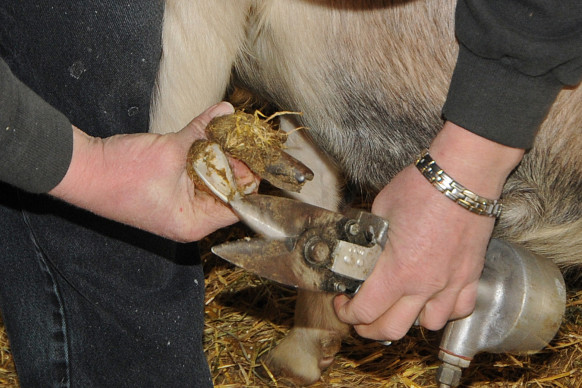Why healthy hooves matter to you, your goats, and the goat industry
Click here for a PDF of this issue of the Goat Gazette.
 Healthy hooves are important for the comfort and welfare of goats. Lameness caused by foot problems can result in reproductive issues, milk production decline, drop in a goat’s body condition score, and shorter longevity in the herd.
Healthy hooves are important for the comfort and welfare of goats. Lameness caused by foot problems can result in reproductive issues, milk production decline, drop in a goat’s body condition score, and shorter longevity in the herd.
Overgrown hooves are a risk factor for development of hoof conditions such as foot scald (interdigital dermatitis), which can lead to foot rot or foot abscess. These conditions impact the welfare of the animal, and affect overall goat health and productivity.
Animals with overgrown hooves who are limping are very susceptible to other leg and joint problems, including arthritis. Goats with sore feet are more reluctant to get up, drink, and eat than healthy animals, which decreases their rate of gain and reduces their nutrition levels.
For meat goats, lower feed consumption ultimately results in less profit when the animals are sent to market; for dairy goats, it directly impacts the quantity and quality of the milk they produce.
Breeding bucks use their hind legs during mating so if their hooves aren’t trimmed, it can seriously affect the mating and reproductive performance of a goat herd.
Many common foot problems can be controlled or even prevented through proper care and management. Not only is this good for the health and productivity of your goat herd, but it’s also important for animal welfare and the way the goat industry is perceived by others.
Society is increasingly turning its eyes on farmers and farm animals. Consumers are curious about how animals are raised and cared for, but also critical of processes they’re not familiar with or things they see that maybe aren’t as they should be.
This makes it important that goat hooves – whether meat or dairy animals regardless of their age – are trimmed regularly.
Here are some healthy hoof tips for your goat herd:
- Trim all hooves regularly, at least two, if not three, times per year. Trimming frequency will vary from farm to farm, and depend on a number of factors, such as the outdoor terrain or barn flooring, animal age, level of activity, rate of gain and genetics. The more frequently hoof trimming is done, the easier the task will be.
- Trim animals with problems or potential problems more regularly – either as a corrective or preventative action. Regular trimming reduces the chance of goats developing infectious and non-infectious hoof lesions.
- Develop a hoof trimming protocol for your farm to ensure trimming gets done. Decide whether you’ll trim a few goats a day or a week, or designate certain times of the year specifically for hoof trimming. Hoof trimming should also be done as needed; therefore if you notice a goat needs their hooves trimmed ensure that the hooves are trimmed right away. Welfare is of the utmost importance.
- Extra attention should be given to the following groups of goats to determine whether or not hoof trimming is required:
- Breeding bucks before mating season
- Yearling does before breeding
- Any goats before shipping off the farm
- Ensure that your goats go to market with trimmed hooves; long hooves are unacceptable for shipping and is an animal welfare concern that reflects badly on you as a producer as well as on the image of the goat industry as a whole.
Careful monitoring can help identify hoof health issues early, so they can be treated before they develop into significant problems. Keep tabs on the condition of your goats’ hooves, their gait, and their behaviour on a daily basis. A preventative hoof care program focused on regular trimming will keep your goats healthy and productive, ensure proper animal welfare, and help maintain positive public perceptions of the goat industry.
For more information on hoof trimming for goats, please contact us.
